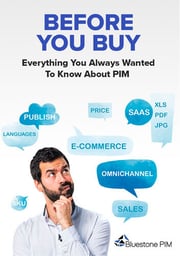Do I really need PIM when I already have an ERP system?
When should I consider implementing a PIM solution in my company?
Why shouldn't I manually update and distribute my product information?
These are the most commonly asked questions we get from our prospects, so we decided to answer these questions in an honest and transparent way.
Truth is, not every eCommerce business needs a PIM. But businesses that use a PIM platform to drive online sales with quality product information experienced higher sales volumes and increased revenue.
For multi-channel retailers especially, using quality PIM software is the only way to stay competitive in the coming years. Let’s see if your business is ready to benefit from a dedicated PIM platform.
You have a large number of SKUs
If you’re running a business with less than 100 SKUs, you don’t need a PIM solution.
Updating this many product descriptions with associated images and prices will take some time, but this shouldn’t be a complex issue that calls for a PIM solution. All you need is a reliable spreadsheet, a good product description template, and some effort on your side to make the product information up-to-date and consistent.
But, if you have 1 thousand to over 2 million SKUs, that is a completely different matter.
Managing such a large number of SKUs is anything but simple, especially when you want to display them in various sales channels. At this stage, relying on spreadsheets is not an effective method, and you should turn to a PIM to manage your product information instead.
Calculate the amount of manual work needed
Use this calculator to estimate the number of product attributes that you'll have to manually update if you do not utilize a PIM software. This will help you see if it is worth your time and effort to manage your product information on your own.
Important tip: Before choosing the best PIM system for your business, be sure to ask the PIM provider if the system can handle importing a growing number of SKUs or a situation when traffic goes up by 100x for a week. The secret ingredient in this recipe is “multi-tenant SaaS.” Why? Because using a cloud-native SaaS PIM means you can easily scale up and down and import a million SKUs from your ERP without any roadblocks or technical difficulties.
Your products share common features
If you have a large portfolio of products that share certain attributes or features, you may find that updating them manually is a lot of repetitive work. It is likely to drain your time and cause many errors and mistakes.
That is when you should consider looking into product information management, portfolio management, and other methodologies to make your work easier.
You need product information to be exact and accurate, and PIM helps you with that by letting you work aggregately with product attributes. Instead of typing or pasting text, you select a product’s attribute from a preset list.
A product can also inherit attributes based on the category it belongs to. It is also very easy to create a variant of a product that only differs in select attributes, like color and size.
The best part is, you only have to do this work once, and your product information is ready to go live on all your sales channels. This wouldn’t be the case if you were managing content directly in your e-commerce store.
Important tip: Taking advantage of similarities and patterns in your product content is especially important when you are working in a team because it makes it easier for everyone to stay in sync. It also secures your interests in the future. As your requirements progress, you will need to process even larger volumes of product content, and you may want to delegate some of the processes to artificial intelligence (AI) and machine learning (ML).
You’re selling products in many digital channels
The days when everyone bought the products they needed from the local shop just down the street are long gone.
Today, according to recent Harvard’s Business Review shopping behavior research, up to 73 percent of customers use multiple channels during their shopping journey, be it to download coupons, read reviews, or compare prices.
Therefore, in order to be a successful e-commerce entrepreneur, you need to allow your customers to interact with products through the medium that is most natural to them and purchase the products directly through that medium.
This might be a web shop, online marketplaces like Amazon, comparison-shopping websites, social media, or even a printed catalog.

Experience tells us that updating and enriching a continuously growing number of products – including multiple attributes and digital media – is extremely time-consuming.
This step becomes even harder to accomplish when the products are displayed in various sales channels. In the long run, mistakes and loss of data quality are inevitable. But it doesn’t have to be this way.
Important tip: At this point, a Product Information Management (PIM) solution is the best investment you can make. You don’t have to manually update every single product in every sales channel. PIM allows you to centrally manage all your product information through a user-friendly dashboard and send the most relevant product content to the right places.
You’re going towards omnichannel
Omnichannel, understood as providing customers with a consistent brand experience, is the future of the e-commerce industry. Just look at the numbers – a new report published by Multichannel Merchant found that 87 percent of retailers said that omnichannel is a critical business function.
Leading brands like Starbucks are already trying to improve customer loyalty and their omnichannel efforts by offering features that straddle the physical and digital divide, like mobile orders with in-store pickups.
Some may say what Starbucks is doing is just an experiment, but in truth, it’s not. It’s the essence of omnichannel and here’s why.
In today's environment, the line between “offline customers” and “online customers” has essentially been erased.
It’s the same customer who just happens to interact with your brand through multiple channels, such as physical stores, e-commerce platforms, emails, pop-ups, call centers, and chatbots. This customer expects the digital and in-store experiences to interact seamlessly.
And it’s your job to make it happen.
Important tip: Product Information Management (PIM) software is the backbone of any robust multichannel or omnichannel philosophy. It allows selling companies to enable their sales and marketing initiatives in a smart, structured way.
You want to improve customer experience
Let’s start with one important question: just how important is the customer experience (CX) for modern-day e-commerce businesses?
According to a B2B Marketing/Earnest survey, 96 percent of respondents said CX would influence whether they purchase from you again, and 83 percent would give a referral as a result of a positive experience.
On the other hand, the same report suggests that a poor customer experience can hurt your business: 13 percent of unhappy customers tell at least 15 people about their frustration.

Looking at these numbers, two conclusions are pretty obvious:
- Customer experience is the new driving factor for competition.
- Word of mouth is a very powerful tool for selling companies.
Important tip: In order to improve customer experience, try to harmonize product information across all channels, devices, and languages to tell a consistent product story. The PIM solution can surely help you with this challenge.
You want to conquer dynamically growing markets
Going forward, international sales are becoming more and more important for each online retailer. And when it comes to e-commerce, no place is more important to be than China, the world’s second-largest economy.
- Fact #1: 40 percent of the world’s e-commerce sales are made in China.
- Fact #2: New digital trends occur first in China and then spread to other parts of the world.
Important tip: If you want to attract new international customers, invest in a quality PIM platform. It’s a perfect tool for building seamless cross-border e-commerce. For instance, life-saving features like multi-language support make it easy to manage the process of translations and localization and speed up the process of product introduction.
Other important e-commerce markets include India, Indonesia, Mexico, the Philippines, Colombia, and the United Arab Emirates.
Undoubtedly all of these markets present fresh sales opportunities for e-commerce companies that are willing to extend their global reach as long as they can provide these customers with product-related content translated into the proper language and can meet local payment preferences.

DOWNLOAD FREE E-BOOK
Leverage product information to turn visitors into customers
Everything you need to know about PIM before you buy it.
Once you reach a saturation point and your team can no longer keep up with manual updates of product content, it’s a sure sign that it’s time to use dedicated technology.
Learn how you can leverage your product content to draw in customers: Drive Online Sales with Product Information: The Ultimate Guide
Do you have a question about PIM, or are you unsure if Bluestone PIM can meet your business requirements? Don't worry, our experts are only an email away. Contact us to set up a meeting to have all of your questions answered, or schedule a demo meeting to see Bluestone PIM in action.
Tags
Customer experience PIM Best Practices Bluestone PIM digital channels Magento 2 omnichannel strategy pim implementation SaaS PIMYou might also like

7 Best Practices for Successful Product Information...

How to Identify True SaaS PIM from Fake SaaS PIM?



